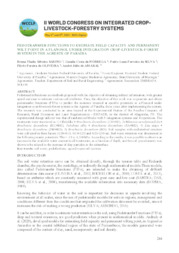Pedotransfer functions to estimate field capacity and permanent wilt point in a Planosol under integration crop-livestock-forest system in the agreste of Paraíba.
Pedotransfer functions to estimate field capacity and permanent wilt point in a Planosol under integration crop-livestock-forest system in the agreste of Paraíba.
Author(s): SABINO, B. T. S.; NÓBREGA, C. C. da; SILVA, P. L. F. da; OLIVEIRA, F. P. de; AMARAL, A. J. do
Summary: Pedotransfer functions are methods proposed with the objective of obtaining indirect information, with greater speed and ease to estimate various soil attributes. Thus, the objective of this work was to generate and obtain pedotransfer functions (PTFs) to predict the moisture retained at specific potentials in a Planosol under integration crop-livestock-forest system in the Agreste of Paraíba, three years after implementing the system. The research was conducted in an area located at the Experimental Station of the Paraíba Company of Research, Rural Extension and Land Regularization - EMPAER, in the district of Alagoinha, PB. The experimental design utilized was that of randomized blocks with 5 integration systems and 4 repetitions. The treatments were structured as 1) Gliricídia + Brachiaria decumbens (GS+BD); 2) Mimosa caesalpiniaefolia+ Brachiaria decumbens (MC+BD); Tabebuia alba + Brachiaria decumbens (TA+BD); 4) Zea mays + Brachiaria decumbens (ZM+BD); 5) Brachiaria decumbens (BD). Soil samples with undisturbed structure were collected in three layers (0.00-0.10; 0.10-0.20 and 0.20-0.30 m). Soil water retention was determined in the following matrix potentials: Psi m = -33 e -1,500 kPa. According to the results, it was possible to observe an increase in the available water content in all treatments, as a function of depth, and the soil granulometry was shown to be related to the increase of clay particles in the subsurface.
Publication year: 2021
Types of publication: Paper in annals and proceedings
Unit: Embrapa Soils
Observation
Some of Embrapa's publications are published as ePub files. To read them, use or download one of the following free software options to your computer or mobile device. Android: Google Play Books; IOS: iBooks; Windows and Linux: Calibre.
Access other publications
Access the Agricultural Research Database (BDPA) to consult Embrapa's full library collection and records.
Visit Embrapa Bookstore to purchase books and other publications sold by Embrapa.

